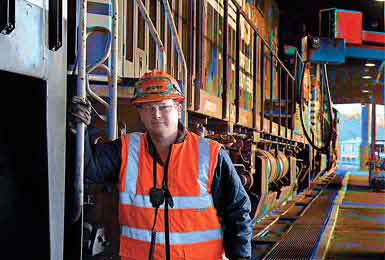Railroads: Still an Important Industrial Link
The manufacturing epicenters of the future will need to integrate supply chain, logistics infrastructure, work force, and community continuous improvement; the presence of rail services is an important link in that chain.
Q1 / Winter 2013

According to Eric Voyles, vice president of National Business Development at the Rockford Area Economic Development Council (Ill.), rail services helped make the Chicago hub area the third-largest logistics port in the world. Many rail-specific services are focused here and such infrastructure is what helps build the region economically. The manufacturing epicenters of the future will need to integrate supply chain, logistics infrastructure, work force, and community continuous improvement; the presence of rail services is an important link in that chain.
Norfolk Southern, for example, has contributed to the expansion of some 32 energy-related facilities in 14 states they serve. Its rail service enabled Marcellus and Utica shale gas exploration projects along with coal and power-generating equipment production. Specifically, the company cites the delivery of Bakken Crude to East Coast refineries as a key development and expects this sub-sector to grow significantly in the year ahead. It also expects its rail service to be an important catalyst in the development of the metals and automotive markets.
“With transportation costs continuing to increase, railroads provide an alternative means for companies to bring their raw materials to facilities and their products to the marketplace,” says Dean Monske, president and CEO of the Regional Growth Partnership in Toledo, Ohio. “When aligned with other modes of transportation — such as interstate, air cargo, or seaport — railroads often complete that final linkage necessary for connectivity to world markets. Railroads open up geography for the transportation of heavy freight or, through their unit trains, long-haul shipments. Working with the railroads to invest more [in infrastructure] unlocks those opportunities.”
Class 1 railroads in the United States have long been actively involved in the economic development of their service areas,” says Newell Baker, Norfolk Southern Corporation’s assistant vice president for Industrial Development. “Norfolk Southern can trace its involvement in economic development to 1896, when its predecessor company, Southern Railway, established a ‘Land and Industrial Department’ to encourage industrial growth in the railway’s service area.”
Shortline railroads also have their place. In Pecos, Texas, Kinder Morgan Texas Pipeline LLC, a shale gas producer, benefited from a new rail terminal developed and operated by Watco Companies, Inc., the largest privately held shortline railroad company in the United States. Kinder Morgan’s President Duane Kokinda says this was instrumental in the company’s expansion. “We believe this unique partnership will provide a wide range of services and expertise for the benefit of customers in Reeves County and surrounding areas,” he notes.
Also in the Permian Basin in West Texas, Crosstex Energy will build a new natural gas processing facility. The company plans to buy and upgrade a nearby rail terminal to provide transportation of natural gas liquids (NGL) to its Eunice fractionation facility in southern Louisiana.
Project Announcements
Coastal Ready Mix Plans Conway, South Carolina, Production Operations
12/20/2025
PRET Advanced Materials Expands Johnsonville, South Carolina, Manufacturing Operations
12/19/2025
Grupo Vialume Plans Colquitt, Georgia, Production Operations
12/19/2025
RelaDyne Expands Hebron, Kentucky, Operations
12/19/2025
Kroger Plans Simpson County, Kentucky, Distribution Operations
12/19/2025
Hines Furlong Line Expands Paducah, Kentucky, Operations
12/19/2025
Most Read
-
The Workforce Bottleneck in America’s Manufacturing Revival
Q4 2025
-
Rethinking Local Governments Through Consolidation and Choice
Q3 2025
-
Lead with Facts, Land the Deal
Q3 2025
-
Investors Seek Shelter in Food-Focused Real Estate
Q3 2025
-
America’s Aerospace Reboot
Q3 2025
-
Tariff Shockwaves Hit the Industrial Sector
Q4 2025
-
The Permit Puzzle and the Path to Groundbreaking
Q3 2025


